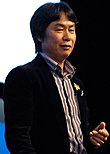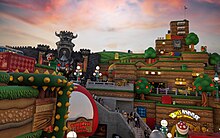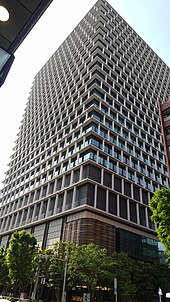Nintendo
[22] In 1933, Sekiryo Kaneda established the company as a general partnership named Yamauchi Nintendo & Co., Ltd.[g][5] investing in the construction of a new corporate headquarters located next to the original building,[23] near the Toba-kaidō train station.[24] Because Sekiryo's marriage to Yamauchi's daughter produced no male heirs, he planned to adopt his son-in-law Shikanojo Inaba, an artist in the company's employ and the father of his grandson Hiroshi, born in 1927.The situation was exacerbated by the falling sales of its adult-oriented playing cards caused by Japanese society gravitating toward other hobbies such as pachinko, bowling, and nightly outings.[35] Yamauchi's experience with the previous initiatives led him to increase Nintendo's investment in a research and development department in 1969, directed by Hiroshi Imanishi, a long-time employee of the company.[5] The year represented a watershed moment in Nintendo's history as it released Japan's first electronic toy—the Beam Gun, an optoelectronic pistol designed by Masayuki Uemura.[40] In 1974, Nintendo released Wild Gunman, a skeet shooting arcade simulation consisting of a 16 mm image projector with a sensor that detects a beam from the player's light gun.[5] During this period, Takeda developed the video game EVR Race,[43] and Shigeru Miyamoto joined Yokoi's team with the responsibility of designing the casing for the Color TV-Game consoles.[57][58][59] Donkey Kong was a financial success for Nintendo both in Japan and overseas, and led Coleco to fight Atari for licensing rights for porting to home consoles and personal computers.[82] In the late 1980s, Nintendo's dominance slipped with the appearance of NEC's PC Engine and Sega's Mega Drive, 16-bit game consoles with improved graphics and audio compared to the NES.[124] The GameCube struggled against its rivals in the market,[125][126] and its initial poor sales led to Nintendo posting a first half fiscal year loss in 2003 for the first time since the company went public in 1962.[167] The financial losses caused by the Wii U, along with Sony's intention to release its video games to other platforms such as smart TVs, motivated Nintendo to rethink its strategy concerning the production and distribution of its properties.[196] In June 2021, the company announced plans to convert its former Uji Ogura plant, where it had manufactured playing and hanafuda cards, into a museum tentatively named "Nintendo Gallery", targeted to open by March 2024.[218] By November 2024, Nintendo gained full ownership of Monolith Soft, a first-party developer behind Xenoblade Chronicles and provided support for The Legend of Zelda: Tears of the Kingdom.The seed capital and product inventory were supplied by the parent corporation in Japan, with a launch goal of entering the existing $8 billion-per-year coin-op arcade video game market and the largest entertainment industry in the US, which had already outclassed movies and television combined.During the couple's arcade research excursions, NoA hired young gamers to work in the poorly maintained warehouse in New Jersey to receive and service game hardware from Japan.The two had already built a decent reputation and a distribution network, founded specifically for the independent import and sales of games from Nintendo because the Japanese company had for years been the under-represented maverick in America.Far East Video took NoA's contract for a fixed per-unit commission on the exclusive American distributorship of Nintendo games, to be settled by their Seattle-based lawyer, Howard Lincoln.Far East Video was already in financial trouble due to declining sales and Ron Judy borrowed his aunt's life savings of $50,000, while still hoping Nintendo would develop its first Pac-Man-sized hit.[230] Amid financial threat, Nintendo of America relocated from Manhattan to the Seattle metro to remove major stressors: the frenetic New York and New Jersey lifestyle and commute, and the extra weeks or months on the shipping route from Japan as was suffered by the Radar Scope disaster.[233][234][235][236][237][238] The company remained at fewer than 10 employees for some time, handling sales, marketing, advertising, distribution, and limited manufacturing[239]: 160 of arcade cabinets and Game & Watch handheld units, all sourced and shipped from Nintendo.With the parent company having no new game ideas, he had been repeatedly pleading for Yamauchi to reassign some top talent away from existing Japanese products to develop something for America—especially to redeem the massive dead stock of Radar Scope cabinets.[240] NoA's staff—except the sole young gamer Howard Phillips—were uniformly revolted at the sight of the freshman developer Miyamoto's debut game, which they had imported in the form of emergency conversion kits for the overstock of Radar Scope cabinets.[237] Arakawa used these profits to buy 27 acres (11 ha) of land in Redmond in July 1982[243] and to perform the $50 million launch of the Nintendo Entertainment System in 1985 which revitalized the entire video game industry from its devastating 1983 crash.[248] Nintendo Treehouse is NoA's localization team, composed of around 80 staff who are responsible for translating text from Japanese to English, creating videos and marketing plans, and quality assurance.[250] In April 2022, an anonymous quality assurance worker filed a complaint with the National Labor Relations Board, alleging Nintendo of America and contractor Aston Carter had engaged in union-busting activities and surveillance.[263] In March 2016, the subsidiary was heavily downsized due to a corporate restructuring after analyzing shifts in the current market, laying off 80% of its employees, leaving only ten people, including CEO Hiroyuki Fukuda.Past the strict guidelines, some exceptions have occurred: Bionic Commando (though swastikas were eliminated in the US version), Smash TV and Golgo 13: Top Secret Episode contain human violence, the latter also containing implied sexuality and tobacco use, River City Ransom and Taboo: The Sixth Sense contain nudity, and the latter also contains religious images, as do Castlevania II and III.The only clear-set rule is that ESRB AO-rated games will not be licensed on Nintendo consoles in North America,[291] a practice which is also enforced by Sony and Microsoft, its greatest competitors in the present market.The company was already the most successful in Japan by 1991, with its products having "redefined the way we play games" and its business model having prioritized title sales strategies over consoles, unlike what most distributors at the time were doing.[307] Its social responsibility policy and philosophy focused on quality and innovation have already led to Nintendo being classified as a "consumer-centric manufacturer", something that has allowed it to differentiate itself from its direct competitors, Sony and Microsoft.








IntendoTrade nameRomanizedPublicTraded asNikkei 225Video gamesElectronicsShimogyō-ku, KyotoFusajiro YamauchiMinami-ku, KyotoShuntaro FurukawaShigeru Miyamotoexecutive fellowList of productsAnimal CrossingArt StyleBig Brain Academybit GenerationsBoxBoy!Brain AgeChibi-Robo!Cruis'nCustom RoboDonkey KongDr. MarioExciteF-ZeroFamicom Detective ClubFire EmblemFossil FightersGolden SunKid IcarusThe Legend of ZeldaThe Legendary StarfyMario KartMario PartyMetroidMotherPikminPilotwingsPokémonPunch-Out!!Puzzle LeagueRhythm HeavenSplatoonStar FoxSuper MarioSuper Smash Bros.Touch! GenerationsXenoblade ChroniclesNintendo eShopMy NintendoNintendo Switch OnlineOperating incomeNet incomeTotal assetsTotal equityThe Master Trust Bank of JapanJPMorgan ChasePublic Investment FundDivisionsEntertainment Planning & DevelopmentPlatform Technology DevelopmentSubsidiaries1-Up StudioMario ClubMonolith SoftNext Level GamesNintendo CubeNintendo European Research & DevelopmentNintendo PicturesNintendo SalesNintendo Software TechnologyNintendo SystemsNintendo Technology DevelopmentRetro StudiosShiver Entertainmentmultinationalvideo gamevideo game consoleshanafudaColor TV-GameNintendo Entertainment SystemSuper Mario Bros.video game industryGame BoySuper Nintendo Entertainment SystemNintendo DSNintendo SwitchSamus AranPikachuNintendo game consolesHAL LaboratoryIntelligent SystemsGame FreakThe Pokémon CompanyEmmy Awards for Technology & EngineeringGame AwardsGame Developers Choice AwardsBritish Academy Games AwardsHistory of NintendokarutaMeiji eraJapaneseplaying cardsPortugueseyakuzamass-produceniche marketRusso-Japanese WarJapan TobaccoTaishō eraJapanese cultureSekiryo Kanedageneral partnershipToba-kaidō train stationHiroshiWorld War IIHigashiyama-ku, KyotostrikeThe Walt Disney CompanyChiyoda, Tokyomarket shareOsaka Securities Exchangepachinko